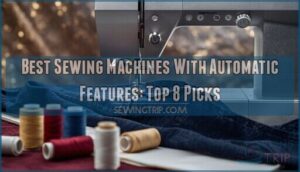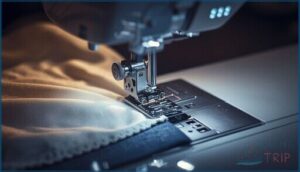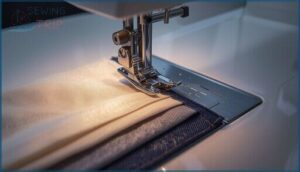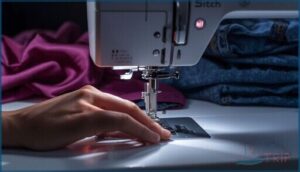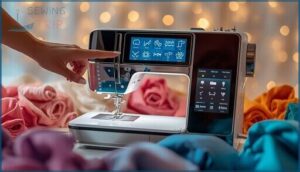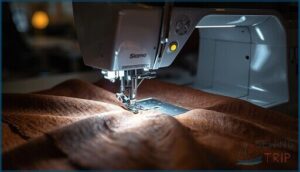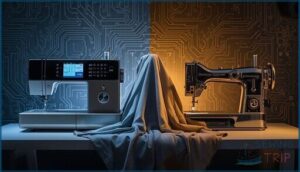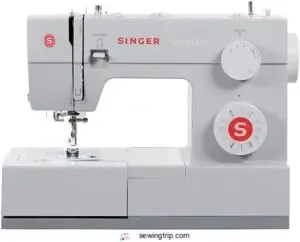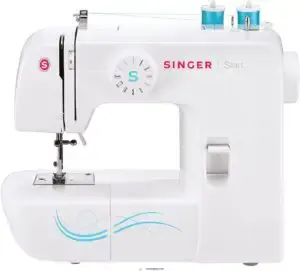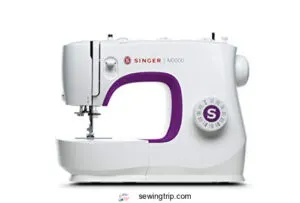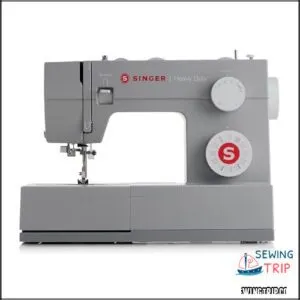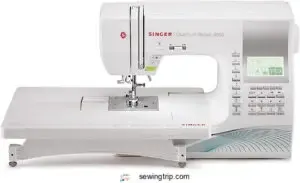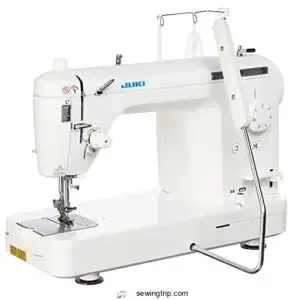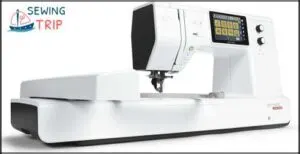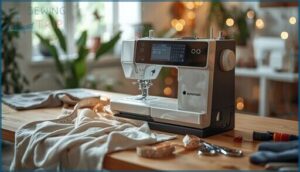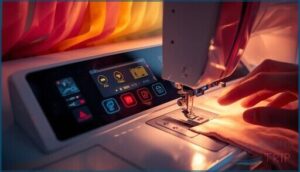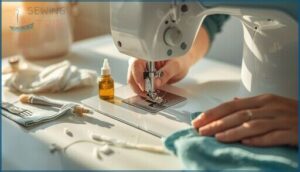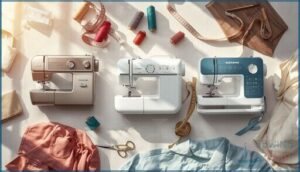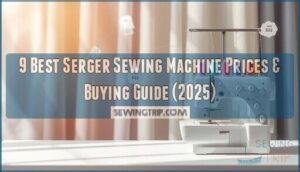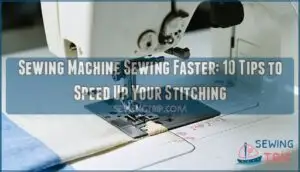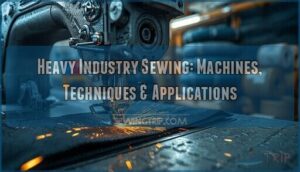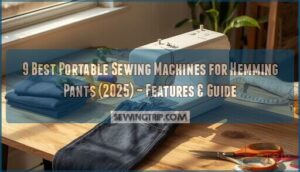This site is supported by our readers. We may earn a commission, at no cost to you, if you purchase through links.
Your needle slips through three layers of denim, the thread cutter snaps clean without reaching for scissors, and you’re already starting the next seam—automatic features have transformed sewing from a test of patience into pure creative flow.
Modern machines handle the tedious setup work that used to eat into project time, letting you focus on the actual craft instead of wrestling with thread tension or squinting at tiny needle eyes. The difference between wrestling with manual adjustments and having technology handle the grunt work isn’t just convenience—it’s the gap between finishing one project a month and completing one every weekend.
Whether you’re stitching heavy canvas bags or delicate quilts, the right automatic features turn repetitive frustrations into smooth, consistent results that look professionally finished.
Table Of Contents
- Key Takeaways
- Key Automatic Features in Sewing Machines
- Computerized Vs Mechanical Sewing Machines
- Top 8 Sewing Machines With Automatic Features
- 1. SINGER Heavy Duty Sewing Machine 4423
- 2. Singer Start 1304 Sewing Machine
- 3. Brother Computerized Sewing and Quilting Machine
- 4. Singer M3500 Sewing Machine with Kit
- 5. Singer Heavy Duty Sewing Machine 4452
- 6. Singer Quantum Stylist Sewing Machine
- 7. Juki Straight Stitch Sewing Machine
- 8. Bernette B79 Sewing and Embroidery Machine
- Choosing The Right Automatic Sewing Machine
- Standout Features for Ease of Use
- Maintenance Tips for Automatic Sewing Machines
- Expert Recommendations for Automatic Sewing Machines
- Frequently Asked Questions (FAQs)
- Conclusion
Key Takeaways
- Automatic features like needle threaders, thread cutters, and one-step buttonholes eliminate tedious manual setup work, transforming sewing from a patience test into an efficient creative flow that lets you finish projects faster with professional-quality results.
- Computerized machines deliver measurable performance gains over mechanical models—including 40% better seam accuracy, 700-1,100 stitches per minute, and programmable settings—though they cost more upfront and require specialized servicing compared to the straightforward maintenance of mechanical machines.
- The right machine depends on matching features to your actual projects: beginners need simple threading and bobbin systems, heavy-duty sewers require powerful motors and metal frames, while quilters benefit from extended workspaces and walking feet.
- Regular maintenance every 8-10 hours of use—including cleaning lint, replacing needles, and following manufacturer service schedules—prevents breakdowns and protects your investment by keeping automated features working smoothly for years.
Key Automatic Features in Sewing Machines
Modern sewing machines pack a lot of automation into their design, and the best ones make your stitching faster and easier. The key features that separate a great machine from an average one are the automatic functions built in—they’re what let you focus on your creativity instead of wrestling with technical details.
Here’s what to look for when you’re evaluating a machine’s automatic capabilities.
Automatic Needle Threader
Ever wished threading a needle could happen in seconds? That’s where an automatic needle threader comes in. This simple feature uses a built-in hook mechanism to guide thread through the needle eye with a single lever action, eliminating eye strain and setup frustration. The machine also provides built-in embroidery patterns for detailed customization.
Key benefits:
- Completes threading in seconds versus multiple manual attempts
- Works seamlessly with most standard polyester and cotton threads
- Integrates with other automatic features for hands-free fabric preparation
Built-in Thread Cutter
While the automatic needle threader saves you setup time, a built-in thread cutter takes efficiency further. This feature trims thread tails automatically after stitching, eliminating manual scissor work and reducing repetitive strain. You’ll notice cleaner seam finishes and a faster workflow. Many mid-range computerized sewing machines now include this, making it accessible without premium pricing. The productivity gains compound across projects, saving time and effort while maintaining professional stitch quality. One of the key benefits is the streamlined sewing operations that reduce overall project time.
| Feature | Benefit | Impact |
|---|---|---|
| Automatic Cutting | Eliminates manual trimming | Reduces fatigue, faster workflow |
| Precision Trimming | Consistent thread lengths | Professional stitch quality |
| Ergonomic Design | Less hand repetition | Lower injury risk |
| Cost Savings | Decreased labor time | Higher throughput |
Automatic Buttonhole Function
Once your thread cuts clean, it’s time to master buttonholes—the feature that separates quick projects from polished ones. Modern automatic buttonhole functions complete the entire buttonhole in one continuous cycle using sensor technology to detect start and stop points. You’ll get consistent stitch uniformity every time, whether you’re working with delicate silk or heavy canvas.
- One-step completion eliminates manual repositioning
- Sensor technology ensures precise stitch placement
- Multiple buttonhole styles adapt to any design
- Programmable settings customize for different fabrics
- Speed accuracy maintains quality at high velocities
Adjustable Presser-Foot Pressure
Getting fabric to feed smoothly requires the right amount of downward force—and that’s where adjustable presser-foot pressure shines. This feature lets you dial in the perfect pressure for everything from delicate silk to thick denim, preventing puckering and ensuring consistent seam quality. Lower pressure stops lightweight fabrics from distorting; higher pressure stabilizes bulky layers. It’s one of the most overlooked yet valuable machine features for improving your results.
| Fabric Type | Pressure Setting | Expected Result | User Benefit |
|---|---|---|---|
| Lightweight (organza, silk) | Low | Smooth seams, no distortion | Prevents drag and stretching |
| Medium (cotton, blends) | Medium | Balanced feed and stitch uniformity | Reliable everyday sewing |
| Heavy (denim, canvas) | High | Stable layering, reduced slippage | Professional-quality seams |
| Bulky (quilts, multiple layers) | Moderate-High | Even compression, less bunching | Better machine compatibility |
Variable Speed Control
When you’re sewing delicate silk or tackling heavy denim, one-speed machines leave you fighting for control. Variable speed control—usually ranging from 200 to 1,100 stitches per minute on household models—lets you slow down for precision work and speed up on straightforward seams.
This design technology prevents seam distortion, reduces beginner errors, and keeps your stitches sharp on curved sections. You’ll complete projects faster while maintaining the quality that separates amateur work from professional results.
Intuitive Stitch Selection
Modern computerized machines put hundreds of stitches at your fingertips through touchscreens and LCD displays that eliminate the guesswork of dial-based controls. Visual stitch previews show exactly what you’ll get before you commit, slashing your learning curve dramatically.
By 2024, roughly 68% of experienced home sewers gravitated toward models offering:
- Digital interface design with app-based customization and Wi-Fi connectivity
- Automated stitch settings that adjust tension and length for your fabric type
- Stitch pattern access spanning 100 to 600 built-in options with one-tap selection
You’ll spend less time deciphering cryptic symbols and more time creating work that reflects your vision.
Built-in Lighting
You won’t squint through another seam once you’ve experienced how built-in lighting transforms your workspace. LED efficiency delivers vivid, focused illumination directly onto your stitching area—boosting stitch visibility while consuming seven times less energy than old-school bulbs.
This ergonomic benefit reduces eye strain during marathon sessions, and light durability means tens of thousands of hours before replacement.
Computerized sewing machines and automatic sewing machine models now include this easy-to-use feature as standard.
Computerized Vs Mechanical Sewing Machines
Choosing between computerized and mechanical sewing machines can feel like standing at a crossroads—each path offers distinct advantages depending on where you want your sewing journey to take you. Computerized models bring precision and programmability to the table, while mechanical machines deliver straightforward reliability that’s stood the test of time.
Let’s break down the key differences so you can find your perfect match.
Feature Comparison
When you’re weighing your options, the gap between computerized and mechanical machines becomes crystal clear. Computerized sewing machines pack 100 to 600 stitches with automatic thread cutter and programmable patterns, while mechanical models offer 10 to 30 basic stitches via manual dials. Around 68% of pros choose computerized for higher automation level and digital stitch selection.
| Feature | Computerized | Mechanical |
|---|---|---|
| Stitch Variety | 100–600 built-in stitches | 10–30 basic stitches |
| Speed Control | Digital slider, variable | Manual foot pedal |
| Automation Level | Thread trimming, tension control | Manual adjustments |
| User Interface | Touchscreen/LCD | Dials and levers |
| Material Handling | Automatic fabric detection | Manual presser-foot tuning |
Performance and Precision
When precision matters, computerized machines deliver measurable gains. Sensor-based control in automatic sewing machine systems cuts seam deviation by up to 40%, while vision guidance achieves stitch accuracy within 0.3 mm on curves. Computerized models run 700–1,100 stitches per minute with adaptive speed control that maintains stitch quality across fabrics. Automatic thread cutter and tension systems reduce defect rates by eliminating operator fatigue, and built-in LED lighting sharpens visibility for consistent stitch consistency.
| Performance Metric | Computerized | Mechanical |
|---|---|---|
| Stitch Accuracy | ±0.3 mm deviation | Manual precision varies |
| Speed Range | 700–1,100 stitches/min | 400–800 stitches/min |
| Defect Reduction | Automated controls lower rework | Operator-dependent |
| Lighting Role | Integrated LED visibility | External lamp required |
| Control Customization | Programmable tension, speed profiles | Fixed mechanical adjustments |
Ease of Use and Maintenance
Easy-to-use features like automatic thread cutters slash setup time by 60–70%, turning a chore into a quick click. Computerized machines pack accessible controls and beginner accessibility, yet they require specialized servicing. Mechanical models shine with simplified maintenance—regular oiling every 8–10 hours and straightforward repairs keep them running for decades.
Here’s how ease of use stacks up against long-term reliability:
| Factor | Computerized | Mechanical |
|---|---|---|
| Learning Curve | Guided menus, auto-threading | Manual setup, tactile adjustments |
| Servicing Interval | 3–6 months (professional tech) | 6–12 months (home DIY) |
| Upkeep Complexity | Electronic diagnostics required | Routine oiling, needle swaps |
| Ergonomic Considerations | Touchscreen, speed control | Foot pedal, lever tension |
Price and Value Considerations
Beyond usability, your budget shapes which automatic sewing machine you bring home. Basic mechanical models run $70–$200, while entry-level computerized machines with needle threaders and push-button stitches start around $200–$600. Mid-range computerized units climb to $1,500, and embroidery combos can hit $5,000. Factor in annual servicing ($75–$250) and repair expenses—some fixes cost more than replacing budget models outright.
| Price Tier | Mechanical | Computerized |
|---|---|---|
| Entry | $70–$200 (basic features) | $200–$600 (auto-threader, LCD) |
| Mid-Range | $200–$600 (stronger build) | $600–$1,500 (stitch libraries, automation) |
| Top-Tier | Rare above $600 | $1,500–$5,000+ (embroidery, wide work area) |
Top 8 Sewing Machines With Automatic Features
Now that you understand the difference between computerized and mechanical machines, it’s time to look at specific models that deliver on automatic features.
The following eight sewing machines represent a range of capabilities and price points, each offering conveniences that can simplify your workflow. Whether you’re tackling heavy fabrics or intricate embroidery, you’ll find options that match your ambitions.
1. SINGER Heavy Duty Sewing Machine 4423
The Singer Heavy Duty Sewing Machine 4423 combines rugged performance with practical automatic features that help you tackle denim, canvas, and multiple fabric layers without breaking stride. You’ll get 23 built-in stitches—including a one-step automatic buttonhole—along with an automatic needle threader that saves time on every project.
With fabric handling boosted by adjustable presser-foot pressure and an extra-high lifter, this heavy-duty machine reaches 1,100 stitches per minute while its metal frame keeps everything stable and precise throughout long sewing sessions.
Best For: Home sewers and small businesses who regularly work with heavy fabrics like denim, canvas, and upholstery and need a fast, reliable machine that can handle thick layers without slowing down.
- Sews at 1,100 stitches per minute with a 60% stronger motor than standard models, making quick work of thick fabrics and multi-layer projects
- Automatic needle threader and one-step buttonhole function save time and reduce frustration on repetitive tasks
- Adjustable presser-foot pressure and extra-high lifter give you control over how different fabric weights feed through the machine
- The instruction manual lacks detail, which can leave beginners struggling to troubleshoot tension or bobbin issues on their own
- Noisy operation and a sensitive foot pedal require some adjustment time before you find a comfortable working rhythm
- Despite the “heavy-duty” label, some users report the machine struggles with very thick materials like multiple layers of leather or heavy canvas
2. Singer Start 1304 Sewing Machine
If you’re stepping into sewing for the first time, the Singer Start 1304 Sewing Machine offers beginner-friendly simplicity without the learning curve. This beginner sewing machine weighs just 10 pounds and delivers 6 preset stitches—including a 4-step buttonhole—along with automatic bobbin winding and tension control that eliminate guesswork.
You’ll appreciate its metal frame, which adds build quality and stability at around 750 stitches per minute, while its compact 13 × 7 × 11.5-inch footprint ensures portability for classes or tight workspaces.
As an automatic sewing machine under $200, it’s a smart value proposition for casual mending and simple garment projects.
Best For: First-time sewers, students taking sewing classes, and anyone who needs a lightweight machine for basic mending, hemming, and simple garment projects without wrestling with complicated settings.
- Automatic tension and preset stitch parameters remove the guesswork, so you can start sewing within minutes even if you’ve never touched a machine before.
- Metal internal frame keeps vibration low and stability high at 750 stitches per minute, giving you smooth operation despite the budget price.
- Compact 10-pound design fits on small desks and travels easily to classes, while the free-arm setup makes cuffs and hems simple to handle.
- Only 6 built-in stitches limit creative options if you want decorative patterns or advanced techniques beyond basic straight and zigzag work.
- Not built for heavy-duty projects like upholstery or thick quilting layers—it’s designed for occasional light use rather than daily intensive sewing.
- Some users find the threading diagrams and manual instructions unclear at first, and the lightweight body can slide on smooth tables when sewing larger fabric pieces.
3. Brother Computerized Sewing and Quilting Machine
For a step up in stitch variety and quilting features, the Brother CS7000X—often listed as the XR9550—gives you 70 built-in stitches, an LCD interface for quick selection, and 750 stitches per minute. This computerized machine includes a wide extension table, walking foot, and ¼-inch piecing foot, making it a solid automatic sewing machine for quilt enthusiasts.
Its metal frame adds durability, and the 25-year warranty backs long-term reliability. At around 14 pounds with an accessory pack of 10 presser feet, it balances portability with automatic features that simplify complex projects.
Best For: Quilters and hobbyists who want computerized convenience, a wide stitch library, and dedicated quilting accessories without jumping to a premium price point.
- 70 built-in stitches with LCD selection and 750 stitches per minute speed up both piecing and decorative work
- Includes a wide extension table, walking foot, and ¼-inch piecing foot—essentials for quilting right out of the box
- Metal frame and 25-year limited warranty provide solid construction and long-term peace of mind
- Electronic components carry only a 2-year warranty, shorter than the chassis coverage
- At 14 pounds with multiple accessories, it’s less compact than simpler mechanical models
- Some users report the automatic needle threader can be finicky and may require adjustment over time
4. Singer M3500 Sewing Machine with Kit
With 110 stitch applications from 32 builtin stitches, the Singer M3500 mechanical features include an automatic needle threader, automatic buttonhole feature, and 750 stitches-per-minute speed—all wrapped in a lightweight frame with LED lighting. Included accessories like multiple presser feet, bobbins, and a seam ripper make this automatic sewing machine ready to tackle garments, quilts, and crafts straight from the box.
However, user feedback highlights reliability issues: bobbin jamming, skipped stitches, and needle threader failures surface often enough to temper expectations. Ease of use shines for occasional projects, but stitch performance can falter under heavy loads.
Best For: Beginners and occasional sewers who need a portable, affordable machine for light garments, simple crafts, and basic mending projects.
- 110 stitch applications with automatic needle threader and one-step buttonhole make setup and garment construction faster for common tasks.
- LED lighting and free arm design improve visibility and access when hemming sleeves, cuffs, or other circular items.
- Lightweight at under 12 pounds with a built-in carry handle, so you can easily move it between rooms or pack it for classes.
- Frequent bobbin jamming and skipped stitches reported by users, suggesting lower reliability than comparable entry-level models.
- Struggles with thick or layered fabrics—needle breaks and jams become common when pushing beyond light to medium materials.
- Automatic needle threader often fails to catch thread consistently, requiring precise alignment and sometimes multiple attempts.
5. Singer Heavy Duty Sewing Machine 4452
If you need heavy-duty performance that won’t quit, the Singer Heavy Duty Sewing Machine 4452 delivers a motor 60% stronger than standard models and hits 1,100 stitches per minute—perfect for punching through denim, canvas, and thick layers.
You’ll get 32 built-in stitches (marketed as 110 stitch applications), an automatic needle threader, and that handy automatic buttonhole feature.
The metal frame keeps everything steady, adjustable presser-foot pressure fine-tunes fabric handling, and the 25-year warranty lifespan backs serious sewing ambitions.
Best For: Sewers who regularly tackle thick fabrics like denim and canvas and want a fast, sturdy machine that can handle heavy-duty projects without slowing down.
- Motor runs 60% stronger than standard models and hits 1,100 stitches per minute, making quick work of multiple fabric layers
- Metal frame and stainless-steel bedplate provide rock-solid stability during high-speed sewing
- 25-year limited warranty on the machine head shows Singer stands behind long-term durability
- Some users report inconsistent stitch quality and reliability issues over time
- Instruction manual gets mixed feedback and may leave beginners hunting for clearer guidance
- Requires regular cleaning and oiling to maintain performance, adding maintenance tasks to your routine
6. Singer Quantum Stylist Sewing Machine
When you’re ready to access 600 built-in stitches and 1,172 stitch applications, the Singer Quantum Stylist 9960 computerized sewing machine brings serious creative firepower. You’ll hit 850 stitches per minute, customize with mirror imaging and five lettering fonts, and breeze through setup thanks to automatic needle threading and a drop-in bobbin.
Automatic features like the thread cutter and one-step buttonholes simplify your workflow, while adjustable speed control and optimum power control keep fabric handling smooth—even through multiple layers.
It’s an adaptable automatic sewing machine built for quilters, crafters, and ambitious sewers.
Best For: Experienced sewers and quilters who want a huge library of stitches and automated features to speed up complex projects, plus beginners willing to work through a learning curve to unlock serious creative options.
- 600 built-in stitches and 1,172 applications give you nearly endless design possibilities for quilting, monogramming, and decorative work
- Automatic needle threader, thread cutter, and one-step buttonholes save time on repetitive tasks and reduce setup frustration
- 850 stitches per minute with adjustable speed control and optimum power handling lets you zip through thick layers or slow down for precision work
- Some users report the needle threader and feed dogs can be finicky or fail, requiring workarounds or repairs
- The sheer number of features and controls can overwhelm beginners, and the manual isn’t always clear
- Mixed reviews on stitch quality and the thread cutter’s reliability suggest inconsistent performance out of the box
7. Juki Straight Stitch Sewing Machine
For pure straight-stitch power, the Juki TL2010Q delivers 1,500 stitches per minute—enough speed to turn quilting marathons into sprints. Its aluminum die-cast frame minimizes vibration at high speeds, while the 12mm presser-foot lift accommodates thick layers with ease.
You’ll appreciate the automatic needle threader, cutting setup time, and the variable speed control that drops down to 55 SPM when precision matters more than pace.
This automatic sewing machine transforms material handling for serious quilters and bag makers who demand industrial-grade stitch quality without compromise.
Best For: Quilters and sewers working on large projects who need industrial-level speed and stitch consistency for straight seams, especially when handling thick fabrics or multiple layers.
- Blazing 1,500 stitches per minute with rock-solid stitch quality thanks to the die-cast aluminum frame that keeps vibration in check even at top speed.
- Automatic needle threader and thread trimmer save you tons of setup time and let you fly through projects without constantly stopping to snip threads.
- Huge work area with the extension table and 12mm presser foot lift make it dead simple to maneuver bulky quilts, denim stacks, or leather without fighting the machine.
- Straight stitch only—if you need zigzag, decorative stitches, or buttonholes, you’ll need a second machine in your lineup.
- At 25 pounds it’s a beast to move around, so plan on leaving it in one spot or getting help when you need to relocate it.
- Some users report the automatic needle threader can be finicky and may need adjustment or stop working altogether over time.
8. Bernette B79 Sewing and Embroidery Machine
When embroidery meets automation in one powerhouse, the Bernette b79 stands out with its 5-inch touchscreen and 500 built-in stitches. This computerized machine combines automatic features like semi-automatic threading, dual feed fabric handling, and programmable foot control to handle everything from quilting to cosplay.
The embroidery capabilities include 208 designs across a 260 × 160 mm area, while automatic thread cutting and tension control keep your workflow smooth. At $2,299, you’re investing in versatility that spans sewing, embroidery, and beyond.
Best For: Crafters who want to tackle sewing, quilting, and embroidery projects without switching machines, especially if you value touchscreen control and built-in design libraries.
- 500 stitches and 208 embroidery designs give you tons of creative options right out of the box
- Dual feed system handles tricky fabrics like knits and slippery materials without shifting
- Automatic thread cutting and tension control speed up your workflow and reduce manual adjustments
- Steep learning curve with complex menus that can overwhelm beginners at first
- Slow startup time and occasional threading issues with the lower bobbin
- Limited accessory availability and support compared to higher-end brands
Choosing The Right Automatic Sewing Machine
Finding the right automatic sewing machine isn’t about picking the flashiest model—it’s about matching features to your actual needs. Whether you’re stitching heavy canvas for upholstery or piecing delicate quilts, the machine you choose should work with your projects, not against them.
The right automatic sewing machine works with your projects, not against them—match features to your actual needs, not flashy specs
Here’s what to think about before you make the investment.
Assessing Your Sewing Needs
Before you commit to a machine, think about how often you’ll actually sew—your sewing frequency shapes whether entry-level features will do or if you need pro-grade automation.
Consider:
- Skill level: Beginner sewers benefit from automatic threading and one-step buttonholers; experienced users want programmable stitch settings.
- Project complexity: Quilts and garments demand different features.
- Budget allocation: Balance must-have functions against your spending limit.
- Space constraints: Compact apartments need foldable designs.
Project Types and Fabric Compatibility
Your projects dictate which features matter most. Garment making demands fabric handling across weights—lightweight sheers need shorter stitch length advice (around 1.8–2.0 mm) and gentle tension control help, while heavy fabrics like denim call for 3.0–4.0 mm stitches and adjustable presser foot settings.
Quilting projects benefit from extended throat space and walking feet that move layered cotton smoothly. Check your fabric weight guide and needle size tips before you choose.
Budget and Versatility
Your budget shapes your feature list, but adaptability can stretch every dollar. Entry-level automatic sewing machines start around USD 200–500, delivering solid stitch variety and accessible features like auto-threaders. Mid-range models (USD 600–1,500) add programmable memory and touchscreens. Factor in accessory costs and tune-up fees (usually USD 50–85) for a true cost-benefit analysis that prioritizes long-term value.
- Beginner-friendly options balance automated functions with affordability
- Feature prioritization helps avoid paying for capabilities you won’t use
- Adaptable machines handle diverse fabrics without breaking your budget
Brand Reputation and Support
A machine with impressive specs won’t carry you far if the brand disappears when you need help. Warranty coverage matters—Janome offers 25 years on mechanical parts, while Bernina and Pfaff back theirs for 20.
Check sewing machine ratings and Expert Recommendations to gauge support quality: Juki, Bernina, and Janome lead in service infrastructure and user experience, ensuring long-term Sewing Machine Longevity you can trust.
Standout Features for Ease of Use
Once you’ve narrowed down your machine options, the real magic lies in features that make your sewing sessions smoother and less frustrating. These aren’t just bells and whistles—they’re the difference between fighting with your machine and actually enjoying your projects.
Let’s look at the standout features that’ll keep you sewing instead of troubleshooting.
Easy-to-Use Controls
A smart control layout makes the difference between fumbling through menus and hitting your stride in minutes. Today’s beginner-friendly models pair straightforward controls—think clearly labeled dials and color-coded threading—with digital interfaces that display stitch parameters in real time.
Touchscreen guidance even walks you through setups, while programmable settings let you save favorites.
Ergonomic feedback, like LED lighting and responsive buttons, keeps every session smooth on any automatic sewing machine with accessible features.
Quick-Set Bobbin Systems
Drop-in bobbin compartments on computerized sewing machines slash setup time to seconds. You’ll see the threading path design through a transparent cover, lay the tail in a groove, and let the hook engage automatically—no manual pulling required.
These jam-resistant features keep stitching smooth, especially for beginners, while the easy-to-use layout and compatibility considerations with pre-wound bobbins make any automatic sewing machine more beginner-friendly.
Programmable Stitch Settings
When you’re ready to take your stitch selection beyond factory presets, programmable stitch settings on computerized sewing machines let you save custom width, length, and tension profiles directly into memory storage capacity. Mid-range models generally offer 50 to 200 stitch options, while premium automatic sewing machine units store up to 600 patterns.
That automation and precision means you’ll replicate complex designs flawlessly every time, with digital integration and market adoption trends proving these features essential for serious sewists.
LCD or Touchscreen Displays
An accessible interface can transform your sewing experience, and LCD screens on computerized machines deliver exactly that. Digital displays simplify every step, from stitch selection to tension adjustments, while error messages instantly guide you through any hiccups.
Feature integration shines through these panels:
- Real-time stitch width and length readings
- Direct on-screen pattern libraries with 100+ options
- Touch-button navigation that cuts setup time
- Visual alerts for threading or bobbin issues
- Preset values you can fine-tune digitally
Market adoption reflects their popularity—68% of professional users prefer LCD-equipped models for precision work.
Maintenance Tips for Automatic Sewing Machines
Keeping your automatic sewing machine in top shape doesn’t require a mechanical engineering degree, but it does need a consistent approach. Regular upkeep prevents frustrating breakdowns and keeps those automated features working smoothly for years.
Here are the essential maintenance practices that’ll protect your investment and keep you sewing without interruptions.
Regular Cleaning and Oiling
Think of regular cleaning as preventive medicine for your machine—it stops problems before they start. You’ll want to oil your machine every 8-10 hours of use, following manufacturer guidelines for your machine type. Remove lint weekly using a small brush rather than compressed air, which pushes debris deeper.
While proper maintenance and cleaning reduce repair costs and boost longterm durability, schedule professional servicing every 1-2 years.
Replacing Needles and Accessories
A dull needle is the fastest path to fabric damage and thread breakage—you’ll know it’s time when skipped stitches or popping sounds appear. Replace your needle every 6-8 hours of sewing to maintain stitch quality, and match needle types to your fabric: universal for cottons, ballpoint for knits, and sharp microtex for silks.
Stock adaptable presser feet like open-toe and ¼-inch patchwork attachments for improved accuracy.
Storing The Machine Properly
Where you park your machine between projects matters more than most sewers realize—humidity control and dust protection prevent rust and mechanical wear that drive up repair costs later.
Keep your machine in a climate-controlled space below 50% humidity, and use a breathable fabric cover instead of plastic to block dust while avoiding condensation.
Pre-storage prep means cleaning lint and applying a light oil film to metal surfaces for long-term protection.
Following Manufacturer Maintenance Schedules
Beyond proper storage, your automatic sewing machine needs scheduled professional attention to protect your investment. Skipping manufacturer intervals can void warranty coverage and push minor issues into expensive repairs—most brands recommend servicing every 12–18 months for hobby users, tightening to 6–9 months if you’re sewing daily.
Here’s what schedule compliance delivers:
- Warranty Implications: Documentation proves proper maintenance when claims arise
- Performance Impact: Regular servicing prevents stitch inconsistencies and mechanical failures
- Longevity Benefits: Scheduled care extends machine lifespan while reducing total repair costs
DIY cleaning helps between visits, but professional technicians catch calibration drift and internal wear your home routine can’t address.
Expert Recommendations for Automatic Sewing Machines
Finding the right automatic sewing machine depends on what you’ll actually use it for. Whether you’re just starting out or tackling industrial-strength projects, there’s a machine built for your specific needs.
Here’s a breakdown of the top performers across different categories to help you find your perfect match.
Best for Beginners
When you’re starting out, ease of learning matters most. The Brother CS7000X stands out as the best sewing machine for beginners, combining automatic needle threading, quick-set bobbin loading, and one-step buttonholes at a cost-effective price.
Another beginner-friendly model, the Brother CS5055, offers an anti-jam bobbin system with simple stitch selection—perfect for tackling your first projects without overwhelming complexity.
Best for Heavy-Duty Projects
For heavy-duty fabrics like multi-layer denim or canvas, you need a machine with serious motor power and frame durability. The SINGER Heavy Duty 4423 delivers 1,100 stitches per minute on a full metal frame, handling fabric thickness with confidence.
Its automatic needle threader and one-step buttonhole add convenience to raw sewing performance, making it the go-to choice for tackling tough materials.
Best for Quilting and Embroidery
Quilting and embroidery demand precision at scale. The JUKI TL-2000Qi runs at 1,500 stitches per minute with an automatic thread cutter and extended 23-inch workspace illumination for managing large quilts. Its computerized stitch regulation facilitates free-motion quilting.
Mid-range Janome models offer automatic thread trimmers and elaborate fabric feeding for embroidery designs. These features turn complex projects into manageable creative adventures.
Best Value for Money
When you’re balancing budget with automatic sewing machine capabilities, the Brother CS7000X delivers serious value. It combines automatic needle threading, quick-set bobbin loading, and one-step buttonholes at a price point that won’t derail your creative plans.
Value-focused picks prioritize:
- Feature prioritization that matches beginner-friendly models with long-term cost efficiency
- Easy-to-use features like automatic threading across budget tiers
- Repair considerations favoring mechanical simplicity
- Sewing machine ratings reflecting brand comparison insights
Frequently Asked Questions (FAQs)
How do automatic tension systems actually work?
Modern computerized machines use thread tension sensors—often strain gauges or load cells—to monitor force continuously. Closed-loop control with actuator mechanisms like servo motors adjusts tension dynamically, improving stitch quality and reducing defects by roughly 40%.
Can automatic features be turned off manually?
Yes, most computerized machines let you disable automatic features like needle threaders, thread cutters, and start/stop buttons. Manual overrides give you user control—reconnect your foot pedal or adjust custom settings for hybrid operation anytime.
Do automatic machines consume more electricity overall?
You might expect computerized models to guzzle energy, yet typical home machines—automatic or mechanical—draw just 20–120 watts. Servo motors and LED lighting actually boost energy efficiency, keeping annual costs under five dollars for most sewers.
What automatic features help prevent fabric puckering?
Adjustable presser foot pressure, automatic tension adjustment, and fabric sensing work together to minimize puckering.
These systems match needle size, improve stitch density, and control fabric feed automatically—reducing seam distortion across different materials.
Are automatic machines louder than mechanical ones?
It’s a myth that automatic machines are inherently louder. Motor noise levels and vibration depend more on motor type than machine features. Computerized models with servo motors often run quieter than older mechanical machines.
Conclusion
Here’s the truth: automatic features don’t just save time—they fundamentally change what you can accomplish at your sewing machine. The best sewing machine automatic features eliminate the technical barriers that once separated hobbyists from professionals, turning complex techniques into accessible skills.
Your next project won’t be limited by your patience with threading needles or calculating buttonhole sizes. It’ll be limited only by your imagination and the fabric you choose to transform.
- https://www.mordorintelligence.com/industry-reports/sewing-machines-market
- https://www.gminsights.com/industry-analysis/computerized-sewing-and-embroidery-machine-market
- https://www.marketgrowthreports.com/market-reports/home-sewing-machines-market-112738
- https://www.industryresearch.biz/market-reports/sewing-machine-market-109816
- https://www.360iresearch.com/library/intelligence/computerized-sewing-embroidery-machine

